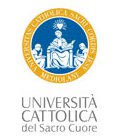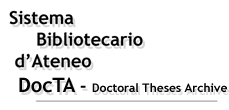|
|
DocTA - Doctoral Theses Archive >
Tesi di dottorato >
SCUOLA DI DOTTORATO IN SISTEMA AGRO-ALIMENTARE >
Citazione:
Utilizza queste indicazioni per citare o creare un link a questo documento.
|
Serra, Paolo. "RISK ASSESSMENT AND ENVIRONMENTAL IMPACT ANALYSIS OF ELECTRICITY GENERATION FROM BIOMASS SORGHUM", Università Cattolica del Sacro Cuore, XXVIII ciclo, a.a. 2014/15, Piacenza, [http://hdl.handle.net/10280/10808].
|
| Titolo: | RISK ASSESSMENT AND ENVIRONMENTAL IMPACT ANALYSIS OF ELECTRICITY GENERATION FROM BIOMASS SORGHUM |
| Autore/i: | SERRA, PAOLO |
| Tutor: | AMADUCCI, STEFANO |
| Coordinatore: | TREVISAN, MARCO |
| Lingua: | ENG |
| Abstract in italiano della tesi: | Questa tesi di dottorato analizza l’utilizzo del sorgo (Sorghum bicolour (L.) Moench) al fine di produrre energia elettrica, tramite combustione diretta della biomassa. Il focus della tesi è stato quello di sottolineare i benefici ed i rischi associati all’uso di tre genotipi di sorgo caratterizzati da diversa lunghezza del ciclo culturale (precoce, medio-tardivo e tardivo).
La dinamica e la durata del processo di essicazione in campo sono state simulate attraverso un modello ad hoc (“sorghum haying model”), il quale integrato a CropSyst, è stato utilizzato per realizzare un’analisi del rischio produttivo stimando le perdite di biomassa (respirazione e meccanizzazione), ed i mancati affienamenti. Nell’analisi del rischio vengono stimati il numero di ettari necessari e la probabilità di eccedere la soglia di 64.000 ton ss anno-1 necessari per l’alimentazione di una centrale nell’Oltrepò pavese .
Inoltre uno studio di Life Cycle Assessment è stato condotto per la valutazione dell’impatto ambientale dell’utilizzo del sorgo integrato a quello della paglia per il completamento del fabbisogno totale della centrale 94.000 ton ss anno-1. Particolare attenzione inoltre è stata data alla variazione del contenuto di C organico del suolo dovuto alla rimozione della paglia ed all’interramento dei mancati affienamenti di sorgo. Il genotipo precoce mostra le migliori performance produttive ed energetiche oltre che la più alta probabilità di eccedere la soglia di 64.000 ton ss anno-1. Lo studio di LCA non ha mostrato differenze significative tra i genotipi anche se il minor impatto ambientale, è stato evidenziato dal genotipo tardivo conseguenza dell’interramento della più alta quantità di mancati affienamenti. |
| Abstract in inglese: | This PhD thesis explores the use of sorghum (Sorghum bicolour (L.) Moench) as a dedicated bio-energy crop and highlights the benefits and risks associated with the use of early, medium-late and late sorghum genotypes to generate electricity by direct combustion in a biomass power plant.
The dynamics and duration of the field drying process were simulated through the development of a specific model ("sorghum haying model"), which integrated with CropSyst, was used to perform a production risk assessment analysis estimating the biomass losses (respiration and mechanical), the haymaking failures and consequently to quantify the amount of dry baled biomass available for the power plant. In addition, the number of hectares needed to plant sorghum and the probability to exceed the threshold of 64000 Mg DM y-1, necessary to feed a biomass power plant in Oltrepò Pavese, were estimated.
A complete Life Cycle Assessment (LCA) study was carried out in order to evaluate the environmental impact of the three sorghum genotypes involved in this study. The LCA study takes into consideration the use of winter wheat straw as an additional biomass source to satisfy the total biomass power plant needs (94000 Mg DM y-1). Particular attention was given to the soil organic C change (ΔSOC) due to straw removal and haymaking failures soil incorporation.
Early genotype showed the best biomass production and energy performance as well as the highest probability to exceed the threshold of 64000 Mg DM y-1. The LCA results did not show significant differences between genotypes although the lower environmental impact, has been achieved by the late genotype due to the highest amount of haymaking failures incorporated in the soil. |
| Data di discussione: | 17-mar-2016 |
| URI: | http://hdl.handle.net/10280/10808 |
| È visualizzato nelle collezioni: | SCUOLA DI DOTTORATO IN SISTEMA AGRO-ALIMENTARE
FACOLTA' DI AGRARIA
|
File in questo documento:
| File |
Dimensioni | Formato | Accessibilità |
|---|
| Tesiphd_completa_Serra.pdf | 4,74 MB | Adobe PDF | Visualizza/apri
|
|
Accesso e utilizzo dei contenuti di DocTA
|



